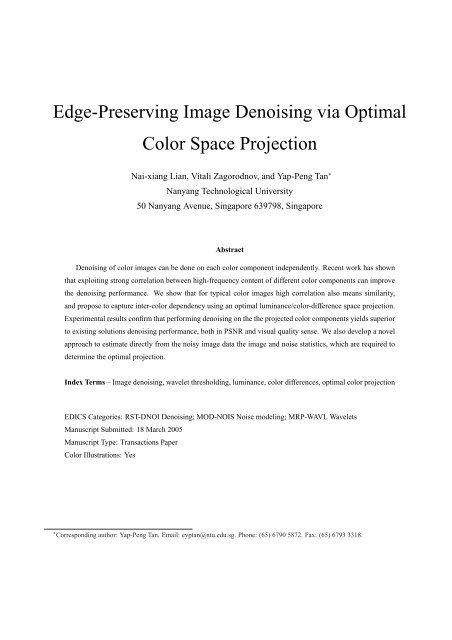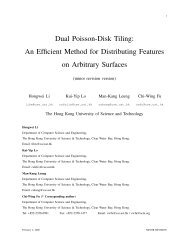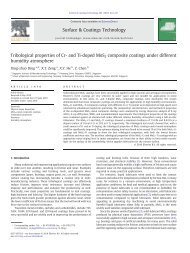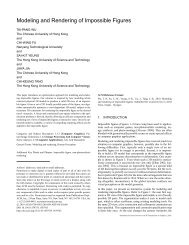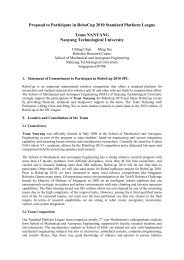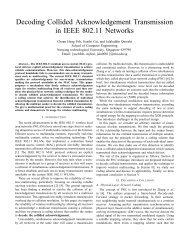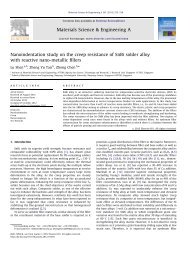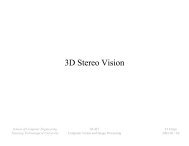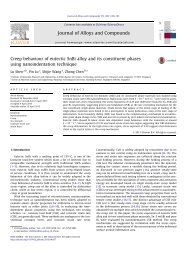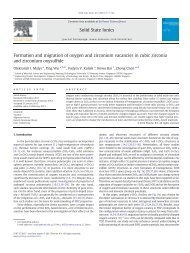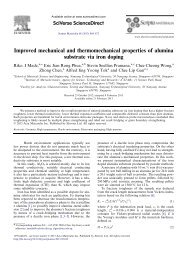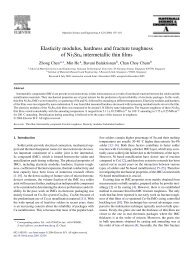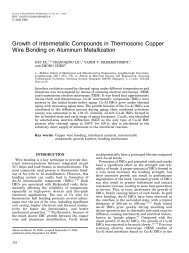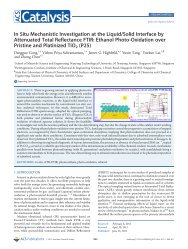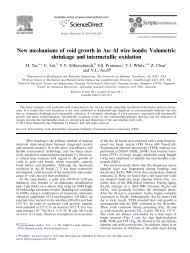Edge-Preserving Image Denoising via Optimal Color Space Projection
Edge-Preserving Image Denoising via Optimal Color Space Projection
Edge-Preserving Image Denoising via Optimal Color Space Projection
Create successful ePaper yourself
Turn your PDF publications into a flip-book with our unique Google optimized e-Paper software.
<strong>Edge</strong>-<strong>Preserving</strong> <strong>Image</strong> <strong>Denoising</strong> <strong>via</strong> <strong>Optimal</strong><br />
<strong>Color</strong> <strong>Space</strong> <strong>Projection</strong><br />
Nai-xiang Lian, Vitali Zagorodnov, and Yap-Peng Tan ∗<br />
Nanyang Technological University<br />
50 Nanyang Avenue, Singapore 639798, Singapore<br />
Abstract<br />
<strong>Denoising</strong> of color images can be done on each color component independently. Recent work has shown<br />
that exploiting strong correlation between high-frequency content of different color components can improve<br />
the denoising performance. We show that for typical color images high correlation also means similarity,<br />
and propose to capture inter-color dependency using an optimal luminance/color-difference space projection.<br />
Experimental results confirm that performing denoising on the the projected color components yields superior<br />
to existing solutions denoising performance, both in PSNR and visual quality sense. We also develop a novel<br />
approach to estimate directly from the noisy image data the image and noise statistics, which are required to<br />
determine the optimal projection.<br />
Index Terms – <strong>Image</strong> denoising, wavelet thresholding, luminance, color differences, optimal color projection<br />
EDICS Categories: RST-DNOI <strong>Denoising</strong>; MOD-NOIS Noise modeling; MRP-WAVL Wavelets<br />
Manuscript Submitted: 18 March 2005<br />
Manuscript Type: Transactions Paper<br />
<strong>Color</strong> Illustrations: Yes<br />
∗ Corresponding author: Yap-Peng Tan. Email: eyptan@ntu.edu.sg. Phone: (65) 6790 5872. Fax: (65) 6793 3318.
1 Introduction<br />
There are two main approaches to image denoising: spatial domain filtering and transform domain filtering.<br />
The spatial domain filtering exploits the correlations between neighboring pixels to remove the noise; particular<br />
techniques include Median and wiener2 filtering [1]. In the last decade, wavelet transform has gained popularity<br />
in image denoising due to its good edge-preserving properties. However, most of the proposed wavelet-based<br />
denoising techniques [2]-[8] assume the image to be grayscale.<br />
Grayscale image denoising can be straightforwardly extended to color images by applying it to each color<br />
component independently. However, better denoising should exploit strong inter-color correlations present in<br />
typical color images. For example, Scheunders [10] used inter-color products of wavelet coefficients to improve<br />
the denoising performance. Pi˘zurica and Philips [11] obtained superior to Scheunders’ performance by updating<br />
local activity parameter of their grayscale image denoiser to the average value of the wavelet coefficients at the<br />
same image location. Scheunders and Driesen [13] treated wavelet coefficients of color components as a signal<br />
vector. Estimated covariance matrix of this vector was used to derive the linear minimum mean squared error<br />
(LMMSE) estimate, capturing inter-color correlations.<br />
Other researchers have proposed to exploit the inter-color correlations by transforming images into a suitable<br />
color space. For example, Ben-Shahar [14] used Hue-Saturation-Value (HSV) color space. Chan et al. [15]<br />
have found that the chromaticity-brightness (CB) decomposition, another color space transformation, can lead<br />
to better restored images than denoising in RGB or HSV space. The CB color space has also been adopted in<br />
several partial differential equation (PDE) based denoising methods [16, 17].<br />
It is easy to show that appropriate color transformation (or projection) can improve the denoising perfor-<br />
mance. <strong>Denoising</strong> in luminance/color-difference space YCbCr [18] improves the performance by up to 1.5 dB<br />
compared to denoising in RGB space; see Table 5. Here we applied a wavelet-based denoising method uHMT [5]<br />
to ten test images shown in Figure 1. However, YCbCr space is not necessarily optimal for image denoising.<br />
In this paper we propose an optimal color space projection that is adapted to image data and yields superior<br />
to existing solutions denoising performance. The projection is derived based on a key observation that high-<br />
frequency wavelet coefficients across image color components are strongly correlated and similar. Even though<br />
the correlation of color components is a well known property, a particularly strong (close to 1) correlation be-<br />
tween high-frequency content of color components has only recently been discovered [22, 24]. This property has<br />
since been successfully applied to color filter array (CFA) demosaicking [20]-[26] and implicitly to color image<br />
denoising [10, 11, 12]. Our work goes a step further and shows that in a typical color image the high frequency<br />
content across color components is not only highly correlated but also similar.<br />
1
Figure 1: Test images (<strong>Image</strong> 1 to <strong>Image</strong> 24, enumerated from left-to-right and top-to-bottom).<br />
High correlation and similarity of detail wavelet coefficients explain the performance gain when denoising in<br />
luminance/color-difference images. The luminance Y is an additive combination of R, G and B color components<br />
and hence preserves the high-frequency image content. On the other hand, the color differences Cb and Cr are<br />
obtained by subtracting the color components: Cb ∝ Y-B and Cr ∝ Y-R. This effectively cancels out high<br />
frequencies, leading to smoother images. These smooth images separate the image signal and noise energy into<br />
low and high frequencies and hence are easier to denoise.<br />
Building on these observations, we make the following contributions:<br />
• We derive an optimal luminance/color-difference space projection that minimizes the noise variance in the<br />
luminance image, leading to better edge preservation. <strong>Color</strong>-difference images comprise a larger portion<br />
of noise but are smooth and hence can be efficiently denoised without sacrificing the quality.<br />
• We propose a method to estimate the image and noise statistics, necessary to derive the optimal color space<br />
projection, directly from the noisy image data. The estimation approach uses similarity of detail wavelet<br />
coefficients to derive an overconstrained system of linear equations. We then solve this system of equations<br />
for the least squares estimates of the signal variance and the covariance matrix of the noise.<br />
The remainder of the paper is organized as follows. In Section 2 we present a series of experiments that con-<br />
firm strong correlation and similarity of detail wavelet coefficients. Section 3 provides a necessary background<br />
2
Table 1: Pairwise correlation of wavelet coefficients in the three finest scales.<br />
<strong>Color</strong> R & G R & B G & B<br />
<strong>Image</strong> Scale LH HL HH LH HL HH LH HL HH<br />
0 0.983 0.993 0.995 0.974 0.991 0.994 0.991 0.996 0.994<br />
1 1 0.978 0.991 0.997 0.969 0.988 0.996 0.992 0.997 0.997<br />
2 0.947 0.968 0.989 0.934 0.954 0.983 0.995 0.995 0.995<br />
0 0.811 0.879 0.969 0.731 0.833 0.963 0.979 0.989 0.980<br />
2 1 0.687 0.834 0.974 0.540 0.755 0.968 0.973 0.985 0.992<br />
2 0.256 0.584 0.857 0.012 0.364 0.822 0.958 0.957 0.985<br />
0 0.942 0.964 0.957 0.880 0.929 0.937 0.887 0.950 0.939<br />
3 1 0.951 0.960 0.974 0.871 0.903 0.952 0.877 0.929 0.962<br />
2 0.917 0.893 0.913 0.737 0.631 0.747 0.767 0.741 0.826<br />
0 0.892 0.967 0.979 0.906 0.970 0.980 0.989 0.993 0.983<br />
4 1 0.878 0.829 0.960 0.895 0.859 0.966 0.991 0.985 0.993<br />
2 0.654 0.637 0.836 0.711 0.698 0.864 0.980 0.977 0.984<br />
0 0.985 0.982 0.989 0.966 0.965 0.984 0.977 0.971 0.979<br />
5 1 0.980 0.975 0.995 0.952 0.950 0.990 0.975 0.967 0.991<br />
2 0.945 0.939 0.970 0.850 0.868 0.929 0.930 0.924 0.963<br />
on wavelet-based denoising. Section 4 proposes an optimal luminance/color-difference projection for image de-<br />
noising. In Sections 5 and 6, we describe the noise estimation procedure and a modified denoising method for<br />
color-difference images. A summary of the proposed denoising method is given in Section 7. Experimental<br />
results are presented in Section 8 to demonstrate the superiority of the proposed method over existing solutions,<br />
both in PSNR and in visual quality. Section 9 concludes the paper and discusses future work.<br />
2 Inter-<strong>Color</strong> Correlations of High-Frequency Coefficients<br />
Gunturk et al. [22] has shown that high-frequency wavelet coefficients of color components are strongly cor-<br />
related, with correlation coefficients ranging from 0.98 to 1 for most images. This property has been widely<br />
exploited in color filter array (CFA) demosaicking [20]-[26]. In CFA imaging, only one color component is<br />
sampled at each pixel location, and the other color components are interpolated (or demosaicked) from their<br />
neighboring samples. Typical CFA demosaicking methods use color differences to reduce the high-frequency<br />
content of the images, leading to the smoother and hence more suitable signals for interpolation. We replicated<br />
Gunturk’s et al. [22] results for Daubechies-4 wavelet 1 [27] and the three finest scales in Table 1. These results<br />
demonstrate that correlations remain strong even for coarser scales. Here LH, HL and HH are vertical, horizontal<br />
and diagonal detail wavelet subbands, respectively. Overall, the correlation in the HH subband appears to be the<br />
strongest among all the subbands.<br />
In general, perfect correlation between two random variables does not necessarily suggest their equality.<br />
1 Its analysis filters are H0 = (−0.1294, 0.2241, 0.8365, 0.4830), H1(n) = (−1) n H0(4 − n), and synthesis filters are G0(n) =<br />
H0(4 − n), G1 = (−1) n H0(n).<br />
3
However, the observed smoothness in color-difference images means that the high-frequency coefficients of<br />
color components are not only correlated but also approximately equal to each other. To demonstrate this we<br />
plotted the 3D scatter diagrams of high-frequency wavelet coefficients in Figure 2. Here, the coordinates of each<br />
point are the magnitudes of the R, G, and B detail wavelet coefficients taken from the same image location of<br />
<strong>Image</strong> 1 in Figure 1. The points are compactly clustered along the line of vector 1 = (1, 1, 1) T . Similar scatter<br />
diagrams can be obtained for all other test images. These results are similar to Hel-Or’s directional derivatives<br />
scatter plots [24], but are extended to all detail wavelet coefficients and fine scales.<br />
(a) LH, scale 0 (b) HL, scale 0 (c) HH, scale 0<br />
(a) LH, scale 1 (b) HL, scale 1 (c) HH, scale 1<br />
Figure 2: Scatter plots of detail wavelet coefficients. The coordinates of each point are the values of the R, G,<br />
and B components.<br />
The scatter plots also suggest that there exists a more efficient basis capable of compact representation<br />
of the wavelet coefficients. This decorrelation property has been extensively employed in color image com-<br />
pression, by transforming the image from RGB to YCbCr space [28]. Let RGB space correspond to the<br />
standard basis in 3D, then the basis vectors for a typical YCbCr space are v = (0.299, 0.587, 0.114) T ,<br />
d1 = (−0.147, −0.289, 0.436) T and d2 = (0.615, −0.515, −0.100) T [18]. Let x1, x2 and x3 be the values<br />
of the R, G and B detail wavelet coefficients (horizontal, vertical or diagonal) of a particular image location,<br />
4
espectively. We call x = (x1, x2, x3) T a signal vector. In Figure 3 we overlay the YCbCr basis vectors on<br />
the scatter plot of all signal vectors. As we can see, vectors d1 and d2 are orthogonal to vector 1. Hence, the<br />
projection of the signal vectors onto d1 and d2 is close to zero. This leads to cancelation of high frequencies and<br />
results in smoother color-difference images that are easier to compress and denoise (see Section 3).<br />
Figure 3: Basis vectors of YCbCr space projection.<br />
Figure 3 also shows that vector v is not aligned with vector 1. The reason is that the luminance Y is chosen to<br />
approximate the grayscale image intensity. This makes YCbCr space backward compatible with the older black-<br />
and-white analog television sets [18]. However, there is a large family of luminance/color-difference spaces, all<br />
having basis vectors d1 and d2 orthogonal to 1, but using different definitions of Y. For example, orthonormal<br />
double-opponent color-difference basis [19] has vector v aligned with 1. However, an efficient basis for a noise-<br />
less image is not necessarily the best for image denoising. This is the topic of Section 4, where we estimate an<br />
optimal space for image denoising from the image noise statistics. To quantify the image denoising performance,<br />
we first introduce several important results from wavelet-based denoising in Section 3.<br />
3 Wavelet-Based <strong>Denoising</strong> of Grayscale <strong>Image</strong>s<br />
Wavelet denoising is typically based on thresholding and/or shrinkage of wavelet coefficients [2, 7]. The main<br />
idea is to classify high frequency wavelet coefficients into two categories, such as Small and Large, or Noise and<br />
Signal [2], and apply different denoising rules to each category. Let x and ˜x be the wavelet coefficient and its<br />
noisy version, i.e., ˜x = x + n, where n is the noise which is assumed to be zero mean and independent from the<br />
5
signal. let q ∈ {S, L} be the state. Then typical denoising rule for coefficients in state q has the following form:<br />
where β(q) ∈ [0, 1] is the shrinkage coefficient.<br />
ˆx = β(q)˜x (1)<br />
Small coefficients correspond to smooth areas of the image; large coefficients occur near the edges. In a noisy<br />
image the coefficients in smooth areas contain primarily noise; hence such coefficients should be reduced or even<br />
put to zero (β is close to 0). On the other hand, the proportion of the noise in the large coefficients near the edges<br />
is small; hence these coefficients should be preserved (β is close to 1).<br />
Hard assignment rules don’t take into account the uncertainty associated with the state estimation. Better<br />
performance can be achieved by computing for each coefficient the probability that it is affected or unaffected<br />
by noise. The manipulation of the coefficient is then based on this probability. Let p(q|˜x) the conditional state<br />
probabilities. In approach by Pi˘zurica and Philips [11] the shrinkage coefficient was varied according to the ratio<br />
of p(L|˜x) and p(S|˜x). In [4, 5] the wavelet coefficients are modelled as a mixture of two zero-mean Gaussian<br />
distributions with variances σ 2 q + σ 2 n, where σ 2 q and σ 2 n are the signal and noise variances respectively. Then<br />
Minimum Mean Square Error (MMSE) estimate of x is<br />
where<br />
ˆx = p(S|˜x)β(S)˜x + p(L|˜x)β(L)˜x (2)<br />
β(q)˜x =<br />
σ2 q<br />
σ 2 q + σ 2 n<br />
˜x, q ∈ {S, L} (3)<br />
are conditional MMSE estimates. Portilla [6] used a similar framework, but modelled the states <strong>via</strong> a continuous<br />
scale parameter.<br />
For the hard assignment based denoising, estimation performance depends on the quality of coefficient clas-<br />
sification and the choice of shrinkage coefficient. Smaller noise leads to better classification and hence better<br />
denoising performance. Classification can also be significantly improved by exploiting intra- or inter-scale corre-<br />
lations [9]. Bao and Zhang [8] showed this by applying shrinkage to inter-scale products of wavelet coefficients.<br />
Similarly, for the soft assignment based wavelet denoising, estimation performance depends on the quality<br />
of obtained conditional state probabilities and the choice of shrinkage coefficient. Estimation of conditional state<br />
probabilities can be improved by exploiting inter- and intra-scale correlations, either through constraining the<br />
wavelet coefficient by it local neighborhood of [6], or joint estimation on a tree [4, 5], or using Markov Random<br />
Field modelling [3].<br />
6
Smaller noise also leads to smaller estimation error in conditional MMSE estimates (3). This is the topic of<br />
the following Lemma.<br />
Lemma 1 For a fixed signal variance σ 2 q, the error of conditional MMSE estimate (3) is a non-decreasing func-<br />
tion of error variance σ 2 n.<br />
Proof: From (3) the estimation error variance is<br />
⎡<br />
ε 2 = E (x − ˆx) 2 = E ⎣<br />
σ 2 n<br />
σ 2 q + σ 2 n<br />
x − σ2 q<br />
σ2 q + σ2 n<br />
n<br />
2 ⎤<br />
⎦ = σ2 qσ 2 n<br />
σ 2 q + σ 2 n<br />
which is a non-decreasing function of σ 2 n for a fixed σ 2 q, as shown in Figure 4. <br />
= σ2 q<br />
σ2 q<br />
σ2 n<br />
Corollary 1 The estimation error variance is always smaller than the signal variance and the noise variance;<br />
i.e.,<br />
∀σ 2 n → ε 2 ≤ σ 2 q, ε 2 ≤ σ 2 n<br />
Corollary 1 explains why it is easier to denoise color differences (Cb and Cr), where suppression of high frequen-<br />
cies leads to small detail wavelet coefficients (or small σ 2 q). Therefore, the estimation error variance is always<br />
small, regardless of how large the noise is, as depicted in Figure 4. This suggests that the denoising performance<br />
can be improved by transforming the image in the color space so that the signal energy is concentrated in one of<br />
the transformed color components. In Section 4 we show that minimizing<br />
The results of Lemma 1 and its corollary are likely to hold even for techniques that don’t use conditional<br />
MMSE estimates. However, the proof will have to be done on a case by case basis and is out of scope of this<br />
paper. Without loss of generality, our experimental results are based on uHMT denoising approach [5].<br />
4 The <strong>Optimal</strong> <strong>Color</strong> <strong>Space</strong> <strong>Projection</strong><br />
In Section 2 we showed that detail wavelet coefficients are strongly correlated across image color components,<br />
with the correlation coefficient close to 1. For the sake of simplicity in our following analysis, we assume perfect<br />
correlation, namely<br />
E(xixj) =<br />
+ 1<br />
<br />
E(x2 i )E(x2 <br />
j ) = s2 i s2 j , ∀i, j (5)<br />
where xi’s are the detail wavelet coefficients in the i-th color component of the noiseless image, and s 2 i ≡ E(x2 i ).<br />
This assumption may not be satisfied exactly in practice and can be relaxed, see Appendix A for the treatment of<br />
the general case of an arbitrary signal covariance matrix.<br />
7<br />
(4)
Estimation error variance<br />
1<br />
0.9<br />
0.8<br />
0.7<br />
0.6<br />
0.5<br />
0.4<br />
0.3<br />
0.2<br />
0.1<br />
0<br />
10 2<br />
10 1<br />
10 0<br />
σ 2<br />
n<br />
10 1<br />
2<br />
σ q = 1<br />
σ 2<br />
q<br />
= 0.1<br />
Figure 4: The estimation error variance as a function of noise variance.<br />
For a typical color image we have s 2 1 s2 2 s2 3 = ¯s2 (see discussion in Section 2). However, the results<br />
derived in this section are applicable to arbitrary signal variances.<br />
Let vector s = (s1, s2, s3) T . We consider a family of luminance/color-difference spaces with basis vectors<br />
(v, d1, d2), where d1 and d2 are orthogonal to s. Our goal is to determine a basis that yields the best denoising<br />
performance. Let xv = v T x be the luminance projection, and xdi = dT i x, i = 1, 2, be the color-difference<br />
projections. Varying the direction of di changes the noise components of xdi<br />
10 2<br />
only; the signal component of<br />
xdi , and hence its variance σ2 q, remains small. This means good denoising performance, as the estimation error<br />
variance ε 2 is always smaller than σ 2 q (see Corollary 1). On the other hand, the luminance xv has a large signal<br />
component. Hence, according to Lemma 1, its denoising performance can be improved by reducing the projected<br />
noise variance.<br />
This observation is illustrated in Table 2, where we apply uHMT denoising to color components in YCbCr<br />
space. <strong>Denoising</strong> Cb and Cr leads to 6-7 dB better PSNR than denoising Y. Hence, the performance of luminance<br />
denoising, and not that of the color differences, is the key factor in the overall denoising performance.<br />
Our goal is to find a basis (v, d1, d2) with optimal luminance projection for image denoising purpose. Note<br />
that the basis is not orthogonal in general, because d1 and d2 can not be simultaneously orthogonal to v and s.<br />
To simplify the analysis we normalize the coordinates of v = (v1, v2, v3) T so that the variance of the signal<br />
projection onto v is fixed. This is the topic of the following lemma.<br />
Lemma 2 Let x be a random vector that satisfies assumption (5). If we normalize v so that v T s = 1, then the<br />
expected squared norm of the projection of x onto v is always equal to 1 and hence doesn’t depend on v.<br />
8
Table 2: PSNR performance (in dB) of Y, Cb and Cr using the uHMT method in the case of uncorrelated noise.<br />
<strong>Color</strong> σn = {0.1, 0.1, 0.1} σn = {0.15, 0.1, 0.05}<br />
<strong>Image</strong> Y Cb Cr Y Cb Cr<br />
1 26.69 37.46 36.68 26.16 38.39 35.69<br />
2 30.96 36.90 35.56 30.59 37.99 34.55<br />
3 30.96 36.43 36.96 30.47 37.81 36.09<br />
4 30.73 37.69 36.14 30.37 38.85 35.16<br />
5 26.80 35.85 36.06 26.18 36.78 35.08<br />
6 27.57 35.99 36.65 26.95 36.15 35.11<br />
7 29.94 36.67 36.78 29.40 37.83 35.80<br />
8 26.48 36.52 35.79 25.42 37.16 34.48<br />
9 30.19 37.04 37.34 29.62 38.06 36.25<br />
10 32.11 37.55 37.51 31.59 38.35 36.41<br />
Average 29.24 36.81 36.55 28.68 37.74 35.46<br />
Proof: Let xv = v T x be the projection of x onto v. Then E(x 2 v) = E(v T xx T v) = v T E(xx T )v. Since the<br />
covariance matrix of the signal is E(xx T ) = ss T , we have E(x 2 v) = v T ss T v = 1. <br />
If the variance of xv is fixed, then choosing the direction of vector v that minimizes the noise projection will<br />
minimize the estimation error of the luminance, as follows from Lemma 1. Yet, this doesn’t guarantee optimality<br />
of v, since the contribution of the luminance component in the inverse formula might depend on v. However, in<br />
Lemma 3 we prove that the constraint v T s = 1 also fixes the contribution of xv in the inverse projection.<br />
Lemma 3 Let x = (x1, x2, x3) T be a random vector that satisfies assumption (5). Let T be an invertible color<br />
projection, such that<br />
⎛<br />
⎜<br />
⎝<br />
xv<br />
xd1<br />
xd2<br />
⎞<br />
⎟<br />
⎠<br />
⎛<br />
⎜<br />
= T ⎜<br />
⎝<br />
x1<br />
x2<br />
x3<br />
⎞<br />
⎛<br />
⎟<br />
⎠ =<br />
⎜<br />
⎝<br />
v T<br />
d T 1<br />
d T 2<br />
⎞ ⎛<br />
⎟ ⎜<br />
⎟ ⎜<br />
⎠ ⎝<br />
where v T s = 1 and d T 1 s = d T 2 s = 0. Then, the corresponding inverse projection is,<br />
where R is a 3 × 2 matrix.<br />
⎛<br />
⎜<br />
⎝<br />
x1<br />
x2<br />
x3<br />
⎞<br />
⎛<br />
⎟<br />
⎠ =<br />
⎜<br />
⎝<br />
s1<br />
s2<br />
s3<br />
⎞<br />
⎟<br />
⎠ xv<br />
⎛<br />
+ R<br />
⎝ xd1<br />
xd2<br />
x1<br />
x2<br />
x3<br />
⎞<br />
⎞<br />
⎟<br />
⎠<br />
(6)<br />
⎠ (7)<br />
Proof: Let T −1 = (r, R), where r is the first column of T −1 . From TT −1 = I it follows that v T r = 1 and<br />
d T 1 r = d T 2 r = 0. Hence, clearly r = s and we obtain (7). <br />
To simplify the inverse projection, we use four basis vectors (one luminance and three color differences)<br />
9
instead of three:<br />
xv = v T x<br />
xdi = xi − sixv = xi − siv T x (8)<br />
One can easily check that so-defined color difference vectors are orthogonal to s. The inverse projection is then<br />
xi = sixv + xdi<br />
Let ˆxi be a denoised version of xi. From (9) it follows that the quality of estimate ˆxi = siˆxv + ˆxdi depends<br />
on v indirectly through the estimation error of ˆxv and ˆxdi . The constraint vT s = 1 fixes the signal variance<br />
of xv according to Lemma 2, and fixes the contribution of xv in the inverse projection according to Lemma 3.<br />
The estimation error of color differences is comparatively small and can be neglected. Hence, choosing v that<br />
minimizes the variance of the luminance noise projection leads to optimal denoising. Lemma 4 relates optimal v<br />
to the signal and noise statistics.<br />
Lemma 4 Let n = (n1, n2, n3) be the noise vector in RGB space and Σn its covariance matrix. Then vector v<br />
with the smallest projected noise variance is<br />
vopt = arg min<br />
vT v<br />
s=1<br />
T Σnv = Σ−1 n s<br />
sT Σ −1<br />
n s<br />
Proof: Let nv = vT n be the projection of n onto v. The variance of nv is E nT <br />
v nv = vT Σnv. According<br />
to Lagrange multiplier method [30], the minimization of v T Σnv under the constraint v T s = 1 is equivalent to<br />
minimization of functional v T Σnv − 2λv T s, where 2λ is the Lagrange parameter. Setting the derivative of the<br />
functional to zero yields<br />
d v T Σnv − 2λv T s <br />
dv<br />
= 2Σnv − 2λs = 0<br />
Solving this equation for v and normalizing the result yields (10). <br />
Figure 5 shows the effect of optimal luminance projection on the denoising performance. Using vopt instead<br />
of v = (0.299, 0.587, 0.114) T from YCbCr leads to better edge preservation and overall image quality.<br />
To obtain vopt we need the noise covariance matrix Σn = E(nn T ), which is typically unknown beforehand.<br />
In Section 5 we discuss how to estimate Σn = E(nn T ) directly from the noisy image data.<br />
10<br />
(9)<br />
(10)
5 Estimation of Noise Covariances<br />
Wavelet coefficients in the HH subband of the finest scale are typically smaller than the coefficients in other<br />
subbands, making it more convenient for noise estimation. For example, in a popular Donoho’s estimator [2], the<br />
standard de<strong>via</strong>tion of the noise is computed as<br />
ˆσn = Median(|˜xi|)<br />
0.6745<br />
where ˜xi are the noisy HH wavelet coefficients. However, in images with fine structures, such as textures, the<br />
HH coefficients are generally larger, leading to potentially inaccurate estimation [8].<br />
Donoho’s estimator can be straightforwardly extended to color images by applying it to each color component<br />
independently. However, this will only produce the estimates of the noise variances and not the noise correlations.<br />
We propose a novel approach capable of estimating the full covariance matrix of the noise, using the similarity<br />
(a) (b) (c)<br />
Figure 5: (a) Noiseless luminance. (b) Denoised luminance using v = (0.299, 0.587, 0.114) T . (c) Denoised<br />
luminance using vopt.<br />
11<br />
(11)
Table 3: Comparison of normalized error of proposed and Donoho’s noise estimator<br />
Noise 2<br />
Uncorrelated Correlated<br />
Uniform Nonuniform Uniform Nonuniform<br />
Covariance matrix Diag. Off-diag. Diag. Off-diag. Diag. Off-diag. Diag. Off-diag.<br />
Donoho’s 0.059 - 0.090 - 0.059 - 0.089 -<br />
Proposed uncorrelated (13) 0.012 - 0.020 - - - - -<br />
Proposed correlated (17) 0.050 0.049 0.089 0.063 0.049 0.033 0.087 0.037<br />
property of detail wavelet coefficients. Unlike Donoho’s approach, our estimates are derived simultaneously for<br />
all color components by solving a system of linear equations. We first discuss the case of uncorrelated noise,<br />
E(ninj) = 0 for i = j, in Section 5.1. A more general case of correlated noise is considered in Section 5.2.<br />
5.1 Estimation of uncorrelated noise variances<br />
Similar to Donoho’s estimator, we use the wavelet coefficients in the HH subband of the finest scale. Table 1<br />
and Figure 2 show that the HH subband coefficients exhibit more similarity than other subbands. We use perfect<br />
correlation assumption (5) and in addition assume that the expected squared norm of the signals is the same for<br />
all color components: E(xixj) = s 2 1 = s2 2 = s2 3 = ¯s2 . Then the covariance matrix of a noisy signal ˜x = x + n<br />
is<br />
⎧<br />
⎨ ¯s<br />
Σ˜x(i, j) = E{˜xi˜xj} =<br />
⎩<br />
2 i = j<br />
where i, j = {1, 2, 3}. Let θ = ¯s 2 , σ 2 n1 , σ2 n2 , σ2 n3<br />
¯s 2 + σ 2 ni i = j<br />
(12)<br />
T be the vector of unknown parameters, and y =<br />
(Σ˜x(1, 1), Σ˜x(2, 2), Σ˜x(3, 3), Σ˜x(1, 2), Σ˜x(1, 3), Σ˜x(2, 1)) T be the data vector. Rewriting (12) in a matrix form<br />
y = B0θ,<br />
we obtain an overconstrained system of 6 equations and 4 unknowns. A least squares estimate (LSE) of θ can be<br />
obtained by using the pseudoinverse of B0 [29]:<br />
ˆθ = B T −1 0 B0 B0y (13)<br />
We applied the Donoho’s estimator and the proposed algorithm to our test images in Figure 1. Table 3 shows<br />
that the normalized average estimation error |ˆσn−σn|<br />
of the proposed algorithm is 4-5 times smaller than the error<br />
σn<br />
of Donoho’s estimator for the case of uncorrelated noise.<br />
2 For the uncorrelated noise, the uniform means equal variance noise added to R, G and B components (σn = {0.1, 0.1, 0.1}),<br />
while the nonuniform means unequal variance noise (σn = {0.15, 0.10, 0.05}). For the correlated noise, the uniform means σn =<br />
{0.10, 0.10, 0.10}, and {0.4, 0.2, 0.3} stands for R&G, R&B, and G&B correlation coefficients respectively. The nonuniform means<br />
12
5.2 Estimation of correlated noise covariances<br />
In general, the noise in different color planes may be correlated:<br />
Σn(i, j) = σ 2 ni,j = E {ninj} = 0, i = j<br />
For example, a high temperature can cause excessive thermal noise on a color sensor. The noise is temperature<br />
dependent and hence is likely to be similar in the local neighborhood of the color sensors [32]. In this case,<br />
assuming uncorrelated noise and using estimate (13) can lead to poor estimates of the luminance basis vector<br />
vopt and hence poor denoising performance, as shown in Table 6.<br />
For correlated noise we can rewrite (12) as<br />
⎧<br />
⎨<br />
Σ˜x(i, j) =<br />
⎩<br />
¯s 2 + σ 2 ni,j i = j<br />
¯s 2 + σ 2 ni<br />
where i, j = {1, 2, 3}. Let θ be the vector of seven unknown parameters (signal variance, three noise variances,<br />
and three noise covariances). Rewriting (14) in a matrix form yields<br />
y = B1θ<br />
This is an underconstrained system with 6 equations and 7 unknowns. To provide additional constraints we use<br />
Donoho’s estimator (11) for σ 2 ni ’s, thus adding three more equations to (14). Let y d be the vector of Donoho’s<br />
estimated noise variances:<br />
i = j<br />
(14)<br />
y d = Aθ (15)<br />
Since Donoho’s estimator is not as accurate as (14), we take (14) as a constraint and obtain a constrained LSE<br />
estimate of (15):<br />
ˆθ = arg min<br />
y=B1θ (y d − Aθ) T (y d − Aθ) (16)<br />
According to Theorem 19.2.1 in [31], ˆ θ is the first part of the solution to the following system of linear equations:<br />
⎛<br />
⎝ A BT 1<br />
B1 0<br />
⎞ ⎛<br />
⎠ ⎝ θ<br />
⎞ ⎛<br />
⎠ =<br />
r<br />
⎝ AT y d<br />
y<br />
σn = {0.05, 0.15, 0.10}, with correlations {0.3, 0.3, 0.3}. The same types of noise are used further in the paper.<br />
13<br />
⎞<br />
⎠
Hence,<br />
⎛<br />
⎝ ˆ θ<br />
r<br />
⎞<br />
⎠ =<br />
⎛<br />
⎝ A BT 1<br />
B1 0<br />
⎞<br />
⎠<br />
−1 ⎛<br />
⎝ AT y d<br />
y<br />
⎞<br />
⎠ (17)<br />
Table 3 shows the estimation performance of the proposed estimator (17) on the diagonal and off-diagonal<br />
entries of the noise covariance matrix. Performance on the diagonal entries is similar to that of the Donoho’s<br />
estimator. The non-diagonal entries are estimated equally well. Hence the estimator (17) can be used in the case<br />
when it is unknown a priori whether the noise is correlated or not.<br />
Even though the assumptions of perfect signal correlation and uniform variances may not be satisfied in real<br />
life, experimental results suggest that estimator (17) is sufficiently precise for the optimal luminance projection-<br />
based wavelet denoising, see Table 6. The PSNR performance is only 0.3-dB worse compared to using exact<br />
noise covariance matrix.<br />
6 <strong>Denoising</strong> of <strong>Color</strong>-Difference <strong>Image</strong>s<br />
Statistical description of the optimal luminance projection resembles that of grayscale images. Hence the standard<br />
grayscale image denoising approaches can be straightforwardly applied to luminance denoising. On the other<br />
hand, the color-difference components are much smoother, and might require some modifications to the existing<br />
grayscale approaches. The modifications are likely to be algorithm dependent and should be decided on a case<br />
by case basis. We consider this problem on the example of uHMT denoising approach.<br />
Compared to grayscale images, the edges of color difference images are smaller in amplitude, leading to<br />
smaller detail wavelet coefficients in the fine scales. For a sufficiently noisy image, the the signal variance in these<br />
scales is much smaller than the noise variance, σ 2 S < σ2 L ≪ σ2 n. This leads to the following two observations:<br />
1. The variances of noisy coefficients in two states are similar to each other, i.e. σ 2 S + σ2 n ≈ σ 2 L + σ2 n, making<br />
it difficult to distinguish these coefficients<br />
2. The shrinkage parameters corresponding to conditional MMSE estimates are close to zero:<br />
σ 2 S<br />
σ 2 S + σ2 n<br />
≈ 0,<br />
σ 2 L<br />
σ 2 L + σ2 n<br />
≈ 0 (18)<br />
The first observations is likely to lead to misclassification of fine scale coefficients. Since the conditional dis-<br />
tributions of large and small coefficients are close to each other, the prior state probabilities p(S), p(L) will be<br />
the deciding factor in computing conditional state probabilities p(q|˜x). Since for a typical image p(S) ≫ p(L),<br />
14
hence p(S|˜x) ≫ p(L|˜x) for a large range of ˜x. This observation is supported by experiment in Figure 6(b):<br />
classifying coefficients according to conditional state probabilities puts an overwhelming majority of fine scale<br />
coefficients into the Small state.<br />
On the other hand, the detail wavelet coefficients in the coarser scales are still large and should allow for a<br />
good separation of large and small coefficients. However, contrary to our expectations, an overwhelming majority<br />
of the coarse-scale coefficients are also classified as small, as shown in Figure 6(b). This can be explained by a<br />
tie between the neighboring scales, which is introduced to exploit the inter-scale correlations [4, 8]. The original<br />
idea of scale connections was primarily for coarser scale coefficients to help classification of the finer scale ones.<br />
In color difference images we obtain an opposite effect - wrongly classified fine scale coefficients adversely affect<br />
the classification in coarser scales.<br />
We propose to resolve this problem by separating the fine and coarse scales using the following simple test:<br />
⎧<br />
⎨<br />
⎩<br />
F ine ˆσ 2 di ≤ tˆσ2 n<br />
Coarse ˆσ 2 di > tˆσ2 n<br />
where ˆσ 2 di and ˆσ2 n are signal and noise variances, estimated from noisy image data, and t is the tolerance parameter<br />
chosen empirically. If the noise dominates the signal, we set the scale as Fine, otherwise we set it as Coarse.<br />
For simplicity we treat all fine scale coefficients as small, since the conditional denoising rules are similar to<br />
each other according to (18). The denoising in coarse scales is done in the same way as before. Scale separation<br />
yields much better classification and denoising performance, as shown in Figure 6(c)(d) and Table 4. In particular,<br />
the proposed modification yields an average PSNR gain of 3 dB in color difference images.<br />
(a) (b) (c) (d)<br />
Figure 6: (a) <strong>Color</strong>-difference image. The sates of wavelet coefficients (b) after uHMT denoising, (c) after uHMT<br />
denoising with Fine/Coarse-Scale separation, and (d) in coarse scale after uHMT denoising with Fine/Coarse-<br />
Scale separation; gray and white pixels correspond to small and large coefficient states, respectively.<br />
15<br />
(19)
Table 4: PSNR performance (in dB) of uHMT on color-difference images with and without Fine/Coarse-scale<br />
separation<br />
<strong>Color</strong> σn = {0.1, 0.1, 0.1} σn = {0.15, 0.1, 0.05}<br />
<strong>Image</strong> Without F/C F/C Without F/C F/C<br />
1 Cb 37.46 41.74 38.39 42.53<br />
Cr 36.68 39.56 35.69 38.66<br />
2 Cb 36.90 39.35 37.99 40.71<br />
Cr 35.56 36.59 34.55 34.75<br />
3 Cb 36.43 38.66 37.81 40.06<br />
Cr 36.96 41.05 36.09 39.78<br />
4 Cb 37.69 43.34 38.85 44.38<br />
Cr 36.14 37.84 35.16 36.88<br />
5 Cb 35.85 36.86 36.78 37.60<br />
Cr 36.06 37.43 35.08 36.48<br />
Average Cb 36.87 39.99 37.96 41.06<br />
Cr 36.28 38.49 35.32 37.31<br />
7 Summary of the Proposed <strong>Denoising</strong> Method<br />
The proposed optimal color projection (OCP) based denoising method consists of the following four key steps:<br />
1. For a given RGB image, use (17) to estimate the covariance matrix of the noise Σn. If the noise is known<br />
to be uncorrelated, then estimator (13) can be used to achieve slightly better performance.<br />
2. Use ˆ Σn and (10) to derive the optimal color projection. Applying it to the original RGB image yields the<br />
optimal projection of luminance ˜xopt and color differences ˜xdi , as defined in (8).<br />
3. Apply the uHMT (or any other grayscale denoising approach) to new color components. If necessary,<br />
modify the algorithm to suit the properties of color differences, as we did with uHMT by Fine/Coarse-<br />
scale separation.<br />
4. Reconstruct the RGB color components using the inverse color projection (9).<br />
Note that the proposed scheme is not constrained by the uHMT denoising approach. Applying optimal projection<br />
to other popular wavelet-based denoising approaches leads to similar performance improvement, as shown in<br />
Section 8.2.<br />
The complexity of the proposed denoising algorithm primarily depends on the adopted denoising method, and<br />
hence is increased by a factor of three-four (depending on the number of color difference components) compared<br />
to grayscale image denoising. The complexities of noise estimation and color projection steps are relatively<br />
small.<br />
16
Table 5: Comparison of CPSNR performance (in dB) of uHMT in RGB, YCbCr, and proposed OCP color spaces<br />
Uncorrelated noise Correlated noise<br />
Uniform Nonuniform Uniform Nonuniform<br />
RGB 27.11 27.19 27.17 27.25<br />
YCbCr 28.22 27.78 27.63 26.91<br />
OCP 28.79 29.51 27.94 29.02<br />
Table 6: Comparison of CPSNR performance (in dB) of Donoho’s and proposed noise estimators<br />
Uncorrelated noise Correlated noise<br />
Uniform Nonuniform Uniform Nonuniform<br />
Donoho 28.92 29.67 27.53 28.92<br />
Proposed 29.17 29.81 28.21 29.31<br />
exact 29.17 29.90 28.28 29.51<br />
8 Experimental Results and Discussion<br />
In our experiments we use 24 test color images shown in Figure 1. As a performance measure we adopt the color<br />
peak signal-to-noise ratio (CPSNR), defined as the average Mean Square Error (MSE) of the denoised color<br />
components, CPSNR = −10 log( 1<br />
3<br />
<br />
c∈{R,G,B} MSEc), for normalized to [0, 1] RGB values.<br />
8.1 Performance contributions of proposed algorithm components<br />
Our proposed algorithm, when coupled with uHMT, consists of three main components (Section 7): optimal color<br />
projection (OCP), noise estimator, and denoising of color difference images with separating Fine/Coarse scales<br />
(F/C). In this section we show the effect of each individual component on the resultant denoising performance.<br />
To demonstrate the effect of color projection we compare the average CPSNR performance of applying<br />
uHMT in RGB, YCbCr and the proposed OCP color spaces in Table 5. <strong>Denoising</strong> in OCP substantially outper-<br />
forms denoising in RGB, by an average of 0.8-2.3dB depending on the relative noise distribution. The difference<br />
between denoising in OCP and YCbCr is more subtle. Average OCP gain over YCbCr is only 0.3-0.6dB for<br />
uniform noise. This can be explained by the similarity of the optimum luminance projection vector and vector<br />
Y = (0.299, 0.587, 0.114) from YCbCr under the uniform noise. However, the performance gain grows up to<br />
1.6-2.1dB for the case of non-uniform noise.<br />
The proposed noise estimation technique also has substantial effect on the overall denoising performance,<br />
especially for the correlated noise. According to results in Table 6, our method outperforms the Donoho’s by<br />
0.15-0.3dB for the uncorrelated noise and by 0.4-0.7dB for the correlated noise. Moreover, this performance is<br />
only about 0.15dB worse compared with the case when exact noise covariance matrix is known.<br />
The proposed separation of Fine/Coarse scale (F/C) in uHMT substantially improves the denoising perfor-<br />
17
Table 7: Comparison of CPSNR performance (in dB) with or without separating Fine/Coase scales (F/C) in<br />
denoising color different images.<br />
Uncorrelated noise Correlated noise<br />
Uniform Nonuniform Uniform Nonuniform<br />
without F/C 28.79 29.51 27.94 29.02<br />
with F/C 29.17 29.81 28.21 29.31<br />
Table 8: CPSNR performance (in dB) by applying OCP into different approaches for grayscale images.<br />
Uncorrelated noise Correlated noise<br />
Uniform Nonuniform Uniform Nonuniform<br />
RGB 27.03 26.95 27.03 26.99<br />
Hard-Thr YCbCr 28.30 27.84 27.71 26.88<br />
OCP 28.73 29.35 27.93 29.19<br />
RGB 27.59 27.48 27.59 27.51<br />
Soft-Thr YCbCr 28.77 28.31 28.19 27.38<br />
OCP 29.21 29.75 28.45 29.54<br />
RGB 27.80 27.72 27.67 27.60<br />
GSM YCbCr 28.90 28.46 28.31 27.52<br />
OCP 29.72 30.44 28.62 29.74<br />
mance of color difference images. The color difference images contribute less to the overall denoising perfor-<br />
mance compared to the luminance. Overall improvement is 0.3-0.4 on average, as shown in Table 7).<br />
In summary, color projection is the main factor in the overall denoising performance improvement, followed<br />
by the noise estimation and the adaption of denoising to color differences. The improvements are already notice-<br />
able for images with uniform uncorrelated noise and become quite substantial in image with correlated and/or<br />
nonuniform noise.<br />
8.2 OCP with other grayscale wavelet-based denoising approaches<br />
The proposed OCP can be combined with any grayscale wavelet-based denoising approach. In Table 8 we show<br />
the results of combining OCP with several existing approaches. In this table, Hard-Thr and Soft-Thr are hard<br />
and soft thresholding of wavelet coefficients proposed in [7]. GSM stands for denoising based on Gaussian Scale<br />
Mixtures model, proposed by Portilla et al [6]. We used redundant wavelet transform in Hard-Thr and Soft-Thr,<br />
and orthogonal wavelet transform in GSM. The observed performance gains are similar to the ones we observed<br />
in uHMT (Table 5).<br />
18
8.3 Comparison to existing state-of-the-art methods<br />
We also compared the proposed OCP denoising with three state-of-the-art methods, wiener filtering wiener2 3 ,<br />
and two recently proposed wavelet-based denoising methods, LSAI 4 [11], MML [13] 5 . For fairness, we adopt<br />
an orthogonal wavelet transform for all wavelet-based tested approaches. As shown in Table 9, the proposed<br />
approach outperforms all others on every test image.<br />
In particular, for uniform noise, the average CPSNR gains of RGB is 3dB, 1.7dB, and 1dB over wiener2,<br />
LSAI, and MML respectively, as shown in Table 10. Even larger gains are achieved for nonuniform noise, where<br />
average PSNR gain for the noisiest component becomes 5dB, 2.7dB, and 1.9dB.<br />
Table 9: CPSNR performance (in dB) of wiener2, LSAI, MML, and OCP methods.<br />
Uncorrelated noise Correlated noise<br />
<strong>Color</strong> Uniform Nonuniform Nonuniform<br />
<strong>Image</strong> wiener2 LSAI MML Ours wiener2 LSAI MML Ours wiener2 LSAI MML Ours<br />
1 24.71 25.25 26.67 27.42 24.36 25.26 27.42 28.73 24.40 25.11 26.93 27.48<br />
2 27.03 29.17 29.20 30.22 26.30 29.07 29.20 30.48 26.73 29.16 29.50 30.14<br />
3 26.87 29.34 29.43 30.54 26.35 29.19 29.66 30.76 26.38 29.14 29.60 30.97<br />
4 26.90 29.10 29.34 30.41 26.33 29.08 29.56 30.85 26.46 29.04 29.41 30.39<br />
5 25.30 24.98 26.47 27.11 24.94 24.94 27.02 28.11 24.93 24.86 26.62 27.34<br />
6 25.13 25.89 27.21 28.01 24.71 25.74 27.37 28.66 24.74 25.76 27.41 28.59<br />
7 26.84 27.93 28.51 29.74 26.30 27.96 28.95 30.46 26.29 27.75 28.73 30.01<br />
8 24.12 25.00 26.40 27.04 23.78 24.88 26.93 28.13 23.83 24.77 26.71 27.39<br />
9 26.71 28.23 28.98 30.24 26.18 28.10 29.32 30.72 26.15 27.97 29.22 30.77<br />
10 27.15 30.55 30.28 32.08 26.53 30.24 30.30 32.63 26.56 30.23 30.46 32.56<br />
11 26.12 26.99 27.95 29.02 25.69 26.90 28.41 29.79 25.60 26.85 28.11 29.27<br />
12 27.00 29.67 29.58 31.04 26.40 29.61 29.70 31.59 26.44 29.18 29.32 30.89<br />
13 24.31 24.10 26.08 26.52 23.94 24.22 26.80 27.80 23.96 24.10 26.06 26.28<br />
14 26.32 26.72 27.56 28.23 25.83 26.59 27.78 28.50 25.82 26.66 27.75 28.42<br />
15 26.94 28.78 28.86 29.96 26.31 28.62 28.80 30.16 26.36 28.37 28.34 29.48<br />
16 26.66 29.05 29.53 30.83 26.17 28.96 29.73 31.70 26.15 28.90 29.73 31.52<br />
17 26.93 28.37 28.84 30.23 26.37 28.32 29.11 31.00 26.25 27.96 28.38 30.24<br />
18 26.37 26.38 27.49 28.19 25.85 26.33 27.76 28.93 25.91 26.33 27.73 28.53<br />
19 25.43 26.53 27.73 28.39 24.97 26.31 27.99 29.16 25.05 26.35 28.15 29.02<br />
20 26.47 27.21 27.39 28.45 25.58 26.63 26.81 28.03 25.77 26.80 26.16 27.37<br />
21 25.85 26.55 27.86 28.76 25.39 26.50 28.32 29.66 25.43 26.43 28.25 28.70<br />
22 26.47 27.49 28.09 28.90 25.86 27.40 28.25 29.54 26.01 27.42 28.35 29.05<br />
23 27.28 30.25 30.13 31.40 26.64 29.93 30.06 31.46 26.70 29.75 30.23 31.32<br />
24 25.68 25.73 26.82 27.52 25.12 25.77 27.19 28.65 25.18 25.50 26.97 27.57<br />
Average 26.19 27.47 28.18 29.17 25.66 27.36 28.44 29.81 25.71 27.27 28.25 29.31<br />
We can provide a simple intuition explaining the outstanding performance of the proposed OCP denoising,<br />
especially on images with non-uniform noise. Existing denoising techniques, such as wiener2, LSAI or grayscale<br />
3<br />
The spatial filtering, the function “wiener2” in MATLAB is used.<br />
4<br />
We used the software provided by the authors with a minor modification to allow for different noise variances in the R,G and B<br />
components.<br />
5<br />
The paper mentions two alternative parameter estimation, using MAP or ML framework. We adopted the latter one since it yields<br />
better CPSNR.<br />
19
Table 10: Average PSNR performance (in dB) of RGB from wiener2, LSAI, MML, and OCP methods.<br />
Uncorrelated noise Correlated noise<br />
Uniform Nonuniform Nonuniform<br />
wiener2 LSAI MML Ours wiener2 LSAI MML Ours wiener2 LSAI MML Ours<br />
R 26.11 27.59 28.20 29.23 23.23 25.88 26.72 28.63 30.22 29.87 30.93 30.94<br />
G 26.15 27.60 28.34 29.43 26.15 27.61 29.00 30.45 23.30 25.84 26.84 28.68<br />
B 26.22 27.86 28.49 29.59 30.30 30.41 31.58 31.82 26.23 27.69 28.70 29.65<br />
approaches in YCbCr assign approximately equal weight to each color component. In the proposed OCP denois-<br />
ing, less noisy channels have larger weight in the final reconstruction. This results in better denoising, since<br />
smaller noise leads to smaller estimation error according to Lemma 1.<br />
Another advantage of the proposed OCP denoising method is better edge preservation. To show this we<br />
partition the image into two regions corresponding to edges and smooth areas, and compare their denoising per-<br />
formance. We use Canny edge detection [33] followed by thresholding to obtain the classification. Table 11<br />
shows the CPSNR of the two regions for wiener2, LSAI, MML, and OCP methods. LSAI uses intra-scale corre-<br />
lations and hence outperforms wiener2 in smooth regions. However, both algorithms achieve similar performance<br />
in the edge regions. The proposed OCP denoising is superior to both LSAI and wiener2, outperforming LSAI by<br />
2-3 dB in edge regions and by 1-1.5 dB in smooth regions. MML denoising fairs well in the edge region, but still<br />
about 0.35-0.9dB worse compared to OCP. However, its performance in the smooth regions is quite poor, even<br />
compared to the LSAI approach.<br />
The visual quality improvements are even more striking than the PSNR gains. We applied the wiener2, LSAI,<br />
MML, uHMT on YCbCr and uHMT on OCP to several test images. The results are shown in Figures 7, 8, and<br />
9. The proposed OCP denoising leads to much fewer color artifacts and better edge preservation compared with<br />
the other methods.<br />
Figure 7 shows an image of a fence. The OCP denoising preserves edges better than the other methods, while<br />
almost completely removing the color artifacts. MML also produces sharp edges, but fails in the smooth regions.<br />
Similar observations can be made for the image of a bird in Figure 8. The LSAI oversmoothes the cheek area<br />
but reveals some color artifacts in the area above the eye. The OCP preserves the cheek texture and successfully<br />
removes the artifacts. An example of the OCP’s superior edge preservation is shown in Figure 9. In the original<br />
image there are several parallel background thin lines that go across the wheel. The OCP denoising is the only<br />
method that preserves these lines without introducing color artifacts in the smooth areas.<br />
20
(a) Origin image (b) Noisy image<br />
(c) wiener2 (d) LSAI<br />
(e) MML (f) Ours<br />
Figure 7: Comparison of different denoising approaches on the fence image corrupted by uncorrelated nonuniform<br />
noise.<br />
21
(a) Origin image (b) Noisy image<br />
(c) wiener2 (d) LSAI<br />
(e) MML (f) Ours<br />
Figure 8: Comparison of different denoising approaches on the parrot image corrupted by uncorrelated nonuniform<br />
noise.<br />
22
Table 11: CPSNR performance (in dB) in the edge (E) and smooth (S) image regions.<br />
Uncorrelated noise Correlated noise<br />
<strong>Color</strong> Uniform Nonuniform Nonuniform<br />
<strong>Image</strong> wiener2 LSAI MML Ours wiener2 LSAI MML Ours wiener2 LSAI MML Ours<br />
1 E 23.28 23.67 25.81 26.15 23.06 23.60 26.71 27.78 23.06 23.50 25.95 26.19<br />
S 26.54 27.37 27.59 28.92 25.94 27.54 28.15 29.81 26.06 27.27 28.02 28.99<br />
2 E 25.93 26.61 27.69 28.28 25.46 26.55 27.88 28.87 25.65 26.73 27.89 28.49<br />
S 27.87 32.10 30.48 32.07 26.90 31.91 30.27 31.94 27.54 31.82 30.89 31.64<br />
3 E 25.42 25.86 27.24 27.65 25.10 25.78 27.68 27.89 25.13 25.86 27.47 28.26<br />
S 27.71 32.76 30.92 32.86 27.04 32.46 30.95 32.91 27.08 32.15 31.02 33.01<br />
4 E 25.97 26.63 27.88 27.29 25.57 26.66 28.32 29.09 25.72 26.77 28.07 28.65<br />
S 27.60 31.93 30.59 31.23 26.88 31.80 30.57 32.50 27.00 31.48 30.52 32.04<br />
5 E 23.79 23.28 25.53 25.78 23.55 23.19 26.25 26.96 23.53 23.20 25.52 25.95<br />
S 27.31 27.38 27.51 28.76 26.70 27.45 27.84 29.48 26.72 27.18 27.91 29.07<br />
6 E 23.48 23.99 26.05 26.47 23.21 24.02 26.66 27.72 23.25 23.92 26.41 27.30<br />
S 27.18 28.45 28.46 29.94 26.47 27.91 28.05 29.61 26.49 28.19 28.44 30.01<br />
7 E 25.33 25.16 26.84 27.43 25.00 25.27 27.53 28.44 25.02 25.12 27.01 27.80<br />
S 27.92 30.72 29.76 31.66 27.18 30.59 29.94 32.10 27.15 30.28 30.02 31.86<br />
8 E 22.38 23.30 25.31 25.45 22.13 23.21 26.15 26.97 22.17 23.00 25.55 25.65<br />
S 25.81 26.64 27.31 28.49 25.32 26.47 27.52 29.08 25.40 26.50 27.67 28.22<br />
9 E 25.13 25.33 27.22 27.84 24.80 25.30 27.85 28.72 24.77 25.20 27.46 28.54<br />
S 27.86 31.27 30.31 32.41 27.13 30.93 30.36 32.31 27.11 30.75 30.55 32.74<br />
10 E 25.89 26.57 28.13 28.87 25.49 26.38 28.52 29.73 25.53 26.49 28.36 29.25<br />
S 27.68 33.60 31.34 34.05 26.94 33.10 31.11 34.37 26.97 32.90 31.48 34.47<br />
11 E 24.53 24.55 26.46 26.21 24.26 24.43 27.13 28.00 24.23 24.54 26.75 27.49<br />
S 27.61 29.95 29.30 29.27 26.98 29.93 29.52 31.60 26.81 29.52 29.30 31.02<br />
12 E 26.06 27.54 28.40 29.35 25.65 27.72 28.86 30.33 25.64 27.18 28.30 29.39<br />
S 27.70 31.85 30.51 32.64 26.95 31.41 30.32 32.68 27.02 31.15 30.09 32.16<br />
Average E 24.76 25.21 26.88 27.23 24.44 25.18 27.46 28.37 24.47 25.13 27.06 27.75<br />
S 27.40 30.34 29.51 31.03 26.70 30.13 29.55 31.53 26.78 29.93 29.66 31.27<br />
9 Conclusions and Future Work<br />
Exploiting inter-color correlations can improve the performance of color image denoising. In this paper we<br />
developed a novel denoising approach that is based on similarity of detail wavelet coefficients across the color<br />
components. The denoising is done by projecting the image onto an optimal luminance/color-difference space<br />
adapted to image noise. The projection minimizes the noise in the luminance component, thus preserving the<br />
high-frequency contents of the image. On the other hand, the color-difference components are smooth and can<br />
be easily denoised regardless of the amount of noise present.<br />
Another contribution of this paper is a novel approach to estimation of the inter-color covariance matrix of<br />
the noise that is used to determine the optimal color projection. The proposed estimator is shown to be more<br />
accurate than the popular Donoho’s estimator in the case of uncorrelated noise. It also demonstrates remarkable<br />
performance for correlated noise across the color components.<br />
Experimental results suggest that the proposed optimal color projection (OCP) denoising method outperforms<br />
23
the existing solutions not only in PSNR but also in visual quality. In particular, the OCP denoising demonstrates<br />
superior edge preservation properties while removing almost all color artifacts.<br />
In the current work we have exploited inter-color correlations, but assumed the noise to be uncorrelated<br />
between the pixels of the same color component. In the future we plan to extend the proposed algorithm to take<br />
into account the noise correlations between neighboring pixels.<br />
A <strong>Optimal</strong> color projection for arbitrary signal covariance matrix<br />
In Section 4 we assumed perfect correlation between detail wavelet coefficients of RGB color components. In<br />
this section we explain how to relax this assumption to an arbitrary covariance matrix Σx. The direction that<br />
preserves energy of the signal is given by the eigenvector of Σx corresponding to largest eigenvalue. Let u0 be<br />
such an eigenvector. It’s easy to check that u0 is a generalization of the signal vector s, since u0 = s when<br />
Σx = ss T . New color difference projection vectors, d1 and d2, are defined as orthogonal to u0.<br />
By normalizing the luminance projection vector v by v T u0 = 1 we satisfy the conditions of Lemma 3. The<br />
so defined basis (v, d1, d2) fixes the contribution of the luminance xv = v T x in the inverse projection. The<br />
estimation error of color differences is comparatively small and can be neglected. Hence, choosing the optimal<br />
v for the luminance noise projection leads to optimal denoising.<br />
However, unlike in the perfect correlation case, the constraint v T u0 = 1 does not fix the variance of xv.<br />
Hence, instead of minimizing the noise projection, we seek a projection that maximizes the signal-to-noise ratio<br />
(SNR). The variance of the signal and the noise projections onto a vector v are E[(v T x) 2 ] = v T Σxv and<br />
E[(v T n) 2 ] = v T Σnv respectively. The following Lemma shows how to obtain v that maximizes ratio vT Σxv<br />
v T Σnv .<br />
Lemma 5 The optimal vector v that yields the largest SNR projection is the eigenvector of the matrix Σ −1<br />
n Σx<br />
corresponding to the largest eigenvalue.<br />
Proof: Setting the derivative of vT Σxv<br />
vT Σnv<br />
to zero yields<br />
<br />
d<br />
vT Σxv<br />
vT <br />
Σnv<br />
dv<br />
= 0 ⇛ Σ −1<br />
n Σxv = vT Σxv<br />
v T Σnv v<br />
Hence the necessary condition for v is to be an eigenvector of Σ −1<br />
n Σx. Let Σ −1<br />
n Σxv = λv. Then<br />
vT Σxv<br />
vT Σnv = vT Σnλv<br />
vT Σnv<br />
24<br />
= λ
Table 12: CPSNR performance (in dB) using the perfect correlation assumption vs arbitrary signal covariance<br />
matrix<br />
Uncorrelated noise Correlated noise<br />
Uniform Nonuniform Uniform Nonuniform<br />
Arbitrary 29.23 29.92 28.29 29.49<br />
Assumption 29.19 29.89 28.28 29.51<br />
Setting v to an eigenvector corresponding to the largest eigenvalue maximizes vT Σxv<br />
vT Σnv<br />
and hence the SNR. <br />
One can check that vector v obtained using Lemma 5 coincides with the one obtained by Lemma 4 when<br />
Σx = ss T .<br />
Signal covariance matrix varies across subband and scales. Hence one can potentially use a different color<br />
projection for each subband and scale of the wavelet tree. However, the main problem here is to estimate the<br />
noise and signal covariance matrices simultaneously. If the noise covariance matrix is known beforehand, the<br />
signal covariance matrix can be estimated using<br />
ˆΣx = E(˜x˜x T ) − Σn<br />
Applying color projection to each scale increases the computational complexity but leads to only modest<br />
improvements in the denoising performance, as shown in Table 12. The difference between CPNSR doesn’t<br />
exceed 0.04dB.<br />
25<br />
(20)
(a) Origin image (b) Noisy image<br />
(c) wiener2 (d) LSAI<br />
(e) MML (f) Ours<br />
Figure 9: Comparison of different denoising approaches on the digital camera test image corrupted by correlated<br />
nonuniform noise.<br />
26
References<br />
[1] A. K. Jain, “Fundamentals of digital image processing”, Prentice Hall, 1989.<br />
[2] D. L. Donoho and I. M. Johnstone, “Adapting to unknown smoothness <strong>via</strong> wavelet shrinkage,” J. Amer.Statist.Assoc.,, vol. 90, pp.<br />
1200-1224, 1995.<br />
[3] M. Malfait and D. Roose, “Wavelet-based image denoising using a Markov Random Field a prior model,” IEEE Trans. on <strong>Image</strong><br />
Processing, vol. 6, no. 4, pp. 549-565, Apr 1997.<br />
[4] M. S. Crouse, R. D. Nowak and R. G. Baraniuk, “Wavelet-based statistical signal processing using Hidden malkov Models,” IEEE<br />
Trans. on Signal Processing, vol. 46, no. 4, pp. 886-902, Apr 1998.<br />
[5] J. Romberg, H. Choi and R. G. Baraniuk, “Bayesian tree-structured image modeling using wavelet-domain Hidden Markov Models,”<br />
IEEE Trans. on <strong>Image</strong> Processing, vol. 10, no. 7, pp. 1056-1068, July 2001.<br />
[6] J. Portilla, V. Strela, M. J. Wainwright, and E. P. Simoncelli, “<strong>Image</strong> <strong>Denoising</strong> Using Scale Mixtures of Gaussians in the Wavelet<br />
Domain,” IEEE Trans. on <strong>Image</strong> Processing, vol. 12, no. 11, Nov 2003.<br />
[7] M.Lang, H.Guo, J. E.Odegard, C. S.Burrus, and R. O.Wells, “Noise reduction using an undecimated discrete wavelet transform” ,<br />
IEEE Signal Processing Letter, vol. 3, pp. 10-12, Jan. 1996.<br />
[8] P. Bao and L. Zhang, “Noise reduction for magnetic resonance images <strong>via</strong> adaptive multiscale products thresholding,” IEEE Trans.<br />
on Medical Imaging, vol. 22, no. 9, pp. 1089-1099, Sep 2003.<br />
[9] J. Liu and P. Moulin, “Information-theoretic analysis of interscale and intrascale dependencies between image wavelet coefficients<br />
” IEEE Trans. on <strong>Image</strong> Processing, vol. 10, no. 11, Nov 2001.<br />
[10] P. Scheunders, “Wavelet thresholding of multivalued images,” IEEE Trans. on <strong>Image</strong> Processing, vol. 13, no. 4, pp. 475-483, Apr<br />
2004.<br />
[11] A. Pi˘zurica and W. Philips, “Estimating probability of presence of a signal of interest in multiresolution single- and multiband<br />
image denoising,” to appear in IEEE Trans. on <strong>Image</strong> Processing.<br />
[12] A. Pi˘zurica, “<strong>Image</strong> denoising using wavelets and spatial context modeling,” Ph.D. thesis, Ghent University, June 2002.<br />
[13] P. Scheunders, J, Driesen,“Least-squares interband denoising of color and multispectral images,” IEEE Int. Conf. <strong>Image</strong> Processing,<br />
Singapore, Oct 2004.<br />
[14] O. Ben-Shahar and S. W. Zucher “Hue fields and color curvatures: a perceptual organization approach to color image denoising,”<br />
IEEE conference on CVPR, June 2003.<br />
[15] T. F. Chan, S. H. Kang, and J. Shen “Total Variation <strong>Denoising</strong> and Enhancement of <strong>Color</strong> <strong>Image</strong>s Based on the CB and HSV <strong>Color</strong><br />
Models,” Journal of Visual Communication and <strong>Image</strong> Representation, vol. 12, pp. 422-435, June 2001.<br />
[16] B. Tang and V. Caselles, “<strong>Color</strong> <strong>Image</strong> Enhancement <strong>via</strong> Chromaticity Diffusion,” IEEE Trans. on <strong>Image</strong> Processing, vol. 10, no.<br />
5, pp. 701-707, May 2001.<br />
[17] S. Kim and S. H. Kang, “Implicit Procedures for PDE-based <strong>Color</strong> <strong>Image</strong> <strong>Denoising</strong> <strong>via</strong> Brightness-Chromaticity Decomposition,”<br />
Technical Report, Department of Mathematics, University of Kentucky, Lexington, KY, July 2002.<br />
[18] C. A. Poynton, “A technical introduction to digital video,” John Wiley & Sons, Inc., 1996.<br />
[19] B. Wandell, “Foundations of vision,” Sinaur Associates, 1995.<br />
27
[20] J. F. Hamilton and J. E. Adams, “Adaptive color plane interpolation in single sensor color electronic camera,” U.S. Patent, no.<br />
5,629,734, 1997.<br />
[21] S. C. Pei and I. K. Tam, “Effective color interpolation in CCD color filter array using signal correlation,” IEEE Int. Conf. <strong>Image</strong><br />
Processing, vol. 3, 2000.<br />
[22] B. K. Gunturk, Y. Altunbasak and R. M. Mersereau, “<strong>Color</strong> plane interpolation using alternating projections,” IEEE Trans. on <strong>Image</strong><br />
Processing, vol. 11, no. 9, pp. 997-1013, Sep 2002.<br />
[23] L. Chang and Y.-P. Tan, “Effective use of Spatial and Spectral Correlations for <strong>Color</strong> Filter Array Demosaicking,” IEEE Trans. on<br />
Consumer Electronics, vol. 50, no. 1, pp. 355-365, Feb 2004.<br />
[24] Y. Hel-Or, “The Canonical Correlations of <strong>Color</strong> <strong>Image</strong>s and their use for Demosaicing,” Technical Report, HP Labs, HPL-2003-<br />
164R1, Feb 2004.<br />
[25] X. Wu and N. Zhang, “Primary-consistent soft-decision color demosaicking for digital cameras,” IEEE Trans. on <strong>Image</strong> Processing,<br />
vol. 13, no. 9, pp. 1263-1274, Sep 2004.<br />
[26] D. D. Muresan and T. P. Parks, “Demosaicking using optimal recovery,” IEEE Trans. on <strong>Image</strong> Processing, vol. 14, no. 2, pp.<br />
267-278, Feb 2005.<br />
[27] I. Daubechies, ”Orthonormal bases of compactly supported wavelets,” Communications on Pure and Applied Mathematics, vol. 16,<br />
pp. 909-996, Jan 1988.<br />
[28] V. Bhaskaran and K. Konstantinides, “<strong>Image</strong> and video compression standards”, Kluwer Academic Publishers, 1995.<br />
[29] B. Widrow, and S. Stearns, “Adaptive signal processing,” New Jersey, Prentice Hall, 1990.<br />
[30] D. P. Bertsekas, “Constrained optimization and Lagrange multiplier methods,” New York, Academic Press, 1982.<br />
[31] D. A. Harville, “Matrix algebra from a statistician’s perspective,” New York, Springer, 1997.<br />
[32] G. C. Holst, “CCD Arrays cameras and displays,” JCD Publishing and SPIE Optical Engineering Press, 1998.<br />
[33] J. F. Canny, “A computational approach to edge detection”, IEEE Trans. on Pattern Analysis and Machine Intelligence, vol. 8, no.<br />
6, pp. 679-698, Nov 1986.<br />
28


